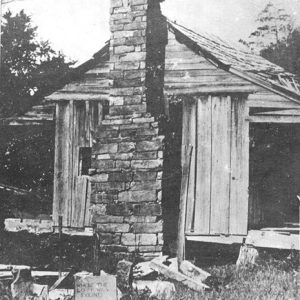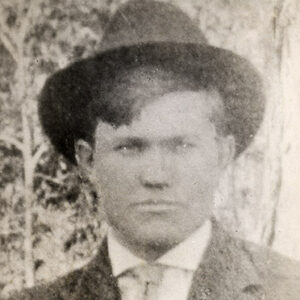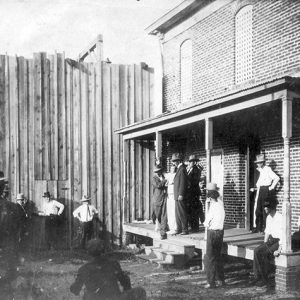calsfoundation@cals.org
John Arthur Tillman (1891–1914)
John Arthur Tillman was the last person executed by hanging in the state of Arkansas. Accused of murdering a girlfriend, Tillman insisted upon his innocence to the day of his death.
John Arthur Tillman was born in January 1891, the third oldest of nine children of John Franklin Tillman, a farmer and cattle breeder, and Lennie Belle Townsell Tillman of Delaware (Logan County). His arrest in 1913 was connected to the March 10 disappearance of Amanda Stephens, age nineteen, who lived north of Delaware. Friends and neighbors said that the two were “seeing each other,” and Stephens left behind a note pinned to her pillow suggesting that she was running away. According to later newspaper reports, she had told friends that she was going dancing with Tillman. Stephens’s father found an unsigned note in the family mailbox arranging a meeting with his daughter. When she did not return home, he sought and received a warrant for the arrest of Tillman, charging him with “seduction.”
On March 18, 1913, Stephens was found dead in a well on the property of Ambrose Johnson. The Johnsons had been out of the area for several days, and after returning, they noticed damage to the exterior of the well. They also said that they saw a man, whom they later identified as Tillman, sneaking up to the well and looking inside. The well had been filled with what was described as “a wagonload of rocks.” With the help of neighbors, Johnson removed the rocks, uncovering the corpse of Stephens. She had a bullet hole through her head and a stone tied to her neck with a telephone wire. An autopsy was conducted, revealing that Stephens was four months pregnant. Suspicion centered upon Tillman as both the father of the unborn child and the murderer of Stephens. Investigators at the time concluded that Stephens had been shot in the head from above with a .22 caliber weapon; evidence found in a cabin ten feet from the well identified it as the murder site. Tillman’s mother informed the authorities that, when he left home the night of March 10, he had taken a .22 caliber rifle with him.
Tillman had fled the area to hide at an uncle’s house following the initial warrant for his arrest for “seduction.” When he was first seized on suspicion of murder, he was held overnight at that same uncle’s house in Clarksville (Johnson County), but Tillman escaped through a window. Several days later, Sheriff Joel Cook traveled to Fort Smith (Sebastian County) to receive a prisoner thought to be Tillman. Although the prisoner had been misidentified, Cook spotted Tillman in Fort Smith and arrested him.
Tillman was tried twice for the murder: the first trial, which began on August 27, 1913, ended with a split decision (or hung jury), but the second ended on November 1 with his conviction and sentencing. After his trial and sentencing, Tillman escaped again, this time jumping from a moving train while being transported from Paris (Logan County) to the state penitentiary in Little Rock (Pulaski County); he was recaptured ten hours later, hobbled by two sprained ankles.
Judge Jeptha Evans originally scheduled the hanging for March 10, 1914, the anniversary of Stephens’s murder, but attempts to appeal the sentence postponed the hanging until July. Meanwhile, state law mandated that all future criminals sentenced to death would be executed by electric chair rather than by hanging. While this law had been passed by the state legislature in February 1913, it could not be implemented until the “execution room” had been constructed at the state penitentiary in Little Rock. The first execution by electrocution took place on September 5, 1913; since Tillman’s trial had begun before that date, Evans was permitted to choose between hanging and electrocution as a means of execution. Up until the date of his execution, Tillman’s family continued to seek a new trial or a commutation of his sentence. Governor George Washington Hays, however, refused to commute the sentence, saying that “the crime was a most atrocious one and if the defendant was innocent, he should not be compelled to spend the rest of his days behind prison walls for a crime committed by some other man, and if he was guilty, no punishment would be too great for him.”
A large crowd of people gathered in Paris for the hanging, scheduled for July 15, 1914. The sheriff had his men under instructions to shoot anyone who might get close to the jail because of rumors that Tillman would be rescued by an armed party. One rumor, reported in the Arkansas Gazette, was that Tillman’s father had recently purchased a high-powered rifle and ammunition, not to rescue his son but to assassinate him in order to spare him the ordeal of hanging. Tillman was also found to have taken a large dose of morphine the day of the hanging, leading some researchers to speculate that he sought to die by poisoning rather than by hanging.
Talking with reporters and with local clergy prior to the hanging, Tillman continued to proclaim his innocence, accusing Earl Bolden, a relative of Stephens, of being the guilty party. Later reports have also raised questions about Tillman’s guilt. Friends of Tillman, as well as both Tillman’s father and Green Stephens, the victim’s father, were named as possible suspects. In 1999, a play based loosely on Tillman’s life and execution, Marked Tree by Coby Goss, premiered in Chicago. The Logan County jail where Tillman was held and hanged has now become the Logan County Museum.
For additional information:
“Arthur Tillman is Hanged at Paris.” Arkansas Gazette. July 16, 1914, p. 1.
Logan County, Arkansas: Its History and Its People. Paris, AR: Logan County Historical Society, 1987.
Paul, David. “Who Murdered Amanda Stevens?” Arkansas Times, October 1985, pp. 102–108.
“Tillman, Awaiting Gallows, Is Calm.” Arkansas Gazette. July 15, 1914, p. 1.
Titsworth, Elizabeth. “The Last Hanging in Arkansas.” Wagon Wheels 12 (Spring 1992): 23–37.
Ryan Walters
Harding University
Staff of the CALS Encyclopedia of Arkansas
 Early Twentieth Century, 1901 through 1940
Early Twentieth Century, 1901 through 1940 Ambrose Johnson Home
Ambrose Johnson Home  Amanda Stephens's Home
Amanda Stephens's Home  Amanda Stephens
Amanda Stephens  Arthur Tillman Hanging
Arthur Tillman Hanging  John Arthur Tillman
John Arthur Tillman  John Arthur Tillman
John Arthur Tillman 




My grandfather, the late Monroe Hodges, collected and transported his coffin to a cemetery near Delaware, Arkansas.
My grandmother Nona Farnam Robinson was a cousin of Arthur Tillman. The story we heard was that the girl was apparently the town whore, but Arthur loved her and was going to marry her. The town sheriff messed around with her along with other townsmen. According to what was told to us, the sheriff and others found out she was pregnant and so they were the ones that killed her and put her in the well. Arthur was blamed for her death and he went on the run. Arthur was innocent according to my grandmother and the family. Interesting story, but I have to believe what the relatives and other old timers told us. Arthur was set up and convicted of her murder. He claimed his innocence until his last breath.
I was born in Logan County in 1929. I lived in close proximity to Paris. The story of John Arthur was one told a lot by the folks living in that area. But the story goes on to say that his father confessed to the murder on his death bed.